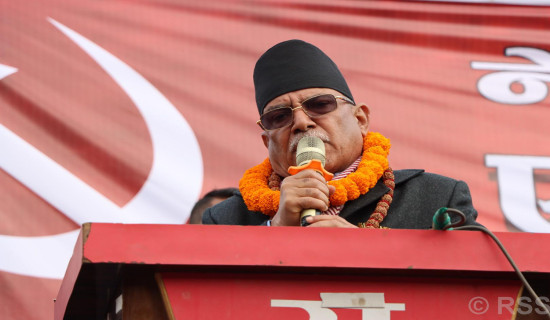- Friday, 2 January 2026
Nature’s Perils
Dixya Poudel
In Nepal, monsoon season is characterised by natural disasters each year. Landslides obstruct highways while floods ravage houses and lands as rain falls torrentially throughout the nation. Monsoon is thus synonymous with natural disasters that test the mettle of the government yearly even though there are mitigation measures in place. It thus questions the current strategies of Nepal government in tackling monsoon-led disasters.
Taking into account Nepal’s geography, 23 districts are at an acute risk of floods while 22 districts are at a high risk of landslides. And it is estimated that about two million people in Nepal will be affected by natural disasters this monsoon. It is a shocking number which can’t be taken lightly. As news is rife with increasing natural calamities across the world, Nepal too is vulnerable to weather extremes, which is why the nation’s government should be put to alert.
As a response, more than 14,000 security forces have been put on standby to provide assistance on relief and rescue operations this year. It has been ascertained that the Armed Police Force (AFP) too is prepared to tackle natural disasters. However, it isn’t only monsoon season that is a cause for alarm. Last year was a cautionary tale for the nation as unseasonal rain damaged crops leading to lower yields. It caused human casualties as well and showed how ill-prepared Nepal is, especially in cases of sudden and unexpected natural disasters.
These unusual weather patterns have been correlated with climate change as the world keeps seeing one weather calamity after another. As witnessed, Nepal isn’t immune either especially as the government seems to be lax on climate sensitive protocols. As deforestation keeps occurring stealthily and often illegally, it leads to increasing run-offs and aggravated soil erosion which only trigger landslides at the nation’s hilly regions.
Additionally, natural disasters are likely to leave a psychological scar on the communities that are at risks. Each monsoon those vulnerable are worried that they might lose their ancestral homes forever. Worse, they fear for their own lives and that of their loved ones. Often those communities who are disaster prone suffer long term anxieties, woes and worries. And due to evacuation and displacement programmes, they may have to start anew in unfamiliar locations with further struggles.
One’s home isn’t only a shelter; it is also where one builds a family life. People who are displaced may never be able to go back to their original homes, either because their homes are destroyed or because the outcomes could be even worse if they were to return. Climate migration thus should be considered a repercussion of natural disasters which have become increasingly unpredictable and erratic in nature. Nepal government should thus strengthen its measures with better implementation of disaster relief programmes.
Likewise, it can invest in preventive strategies such as forestations and river embankments. It is equally vital to curb surface run-offs that are a major aggravator of landslides. Climate related protocols should be given priority to minimise and mitigate the effects of climate change as extreme weather has become a reality and a growing menace. As such, it has been predicted that this monsoon will be especially torrential in Nepal which is why disaster vulnerable communities should be better equipped with both preventive and rehabilitative measures.

















